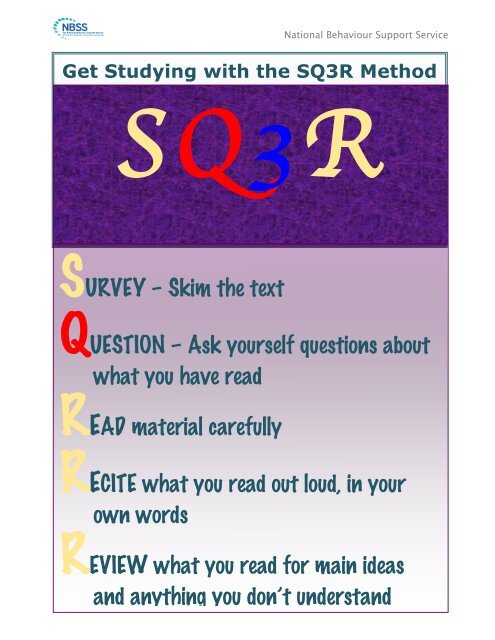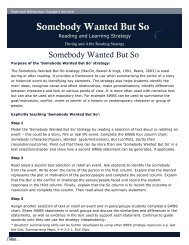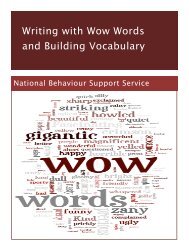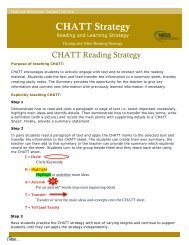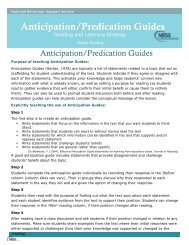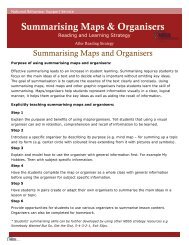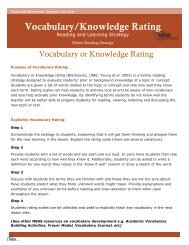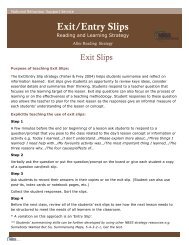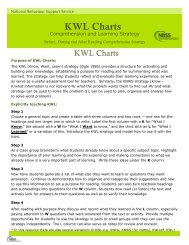SQ3R - NBSS
SQ3R - NBSS
SQ3R - NBSS
- No tags were found...
Create successful ePaper yourself
Turn your PDF publications into a flip-book with our unique Google optimized e-Paper software.
National Behaviour Support Service<br />
Get Studying with the <strong>SQ3R</strong> Method<br />
<strong>SQ3R</strong><br />
SURVEY – Skim the text<br />
QUESTION – Ask yourself questions about<br />
what you have read<br />
READ material carefully<br />
RECITE what you read out loud, in your<br />
own words<br />
REVIEW what you read for main ideas<br />
and anything you don’t understand<br />
<strong>SQ3R</strong> Study Method 1
<strong>SQ3R</strong><br />
National Behaviour Support Service<br />
Survey,<br />
What is the <strong>SQ3R</strong> Study System<br />
Question, Read, Recite, Review<br />
Why use the <strong>SQ3R</strong> System<br />
1. It provides an overview.<br />
2. Organises chapter(s) in a framework which connects the loose<br />
pieces of new information.<br />
3. Focuses reading and encourages who, what, when, where and<br />
how questions as answers are identified.<br />
4. Provides repetition and rehearsal necessary for learning.<br />
5. It helps you remember what you need to know!<br />
<strong>SQ3R</strong> Study Method 2
The Basic Steps:<br />
National Behaviour Support Service<br />
1. SURVEY headings<br />
2. QUESTION headings (turn heading into<br />
questions)<br />
3. READ the section to answer the<br />
question.<br />
4. RECITE out loud your answer to the question. Write down<br />
important sentence under each heading.<br />
5. REVIEW notes when you have read the chapter.<br />
<strong>SQ3R</strong><br />
SURVEY: Glance over the headings in the chapter to see the main<br />
points which will be developed in the chapter. Also, read the final<br />
summary paragraph if the chapter has one. This survey should not<br />
take more than a minute and will show the three to six core ideas<br />
about the topic. This will help you organise the ideas as you read them<br />
later.<br />
QUESTION: Now begin work. Turn the first heading<br />
into a question. (e.g. Heading = Martin Luther. My<br />
question = Who was Martin Luther and why is he<br />
important). This will focus your reading and so<br />
increase your understanding. It will help you<br />
remember information you already know, which in turn will help you to<br />
understand that section more quickly. And the question will make<br />
important points stand out from the detail. Turning a heading into a<br />
question can be done very quickly when reading, but it then demands<br />
you put effort into reading to find the answer to the question you<br />
created. (All this helps you understand and remember the<br />
information). (You can use question stems to help you create different<br />
kinds of questions and questions that require more complex answers.<br />
See sample sentence stems sheet).<br />
READ: Read to the end of the first headed section, reading<br />
to answer that question. This is not a passive plodding<br />
<strong>SQ3R</strong> Study Method 3
National Behaviour Support Service<br />
along each line, but an active search for the answer. (Be ready,<br />
however, to refocus your reading and change your question if you find<br />
you have asked the wrong question!).<br />
RECITE: Having read to the end of the first headed section, look<br />
away from the book and try briefly to recite out loud the answer to<br />
your question – (or in your head if other people are around). Use your<br />
own words and include an example. If you can do this you know what<br />
is in the chapter/topic. If you can’t, glance over the section again. An<br />
excellent way to do this reciting from memory is to jot down key<br />
phrases and words on a sheet of paper. Make the notes very brief. No<br />
notes are written until the whole section is completely read.<br />
Now repeat the QUESTION, READ AND RECITE steps for the following<br />
sections in the chapter. That is, turn the next heading into a question,<br />
read to answer that question and recite the answer by jotting down<br />
key phrases and words on your outline/rough page. Read this way<br />
until the entire section/topic is completely read.<br />
REVIEW: When the section has been completely read, look over your<br />
notes to get a bird’s eye view of the points and their relationship and<br />
check your memory by reciting (out loud or in your head) the major<br />
sub points under each heading. This checking of memory can be done<br />
by covering up the notes and trying to recall the sub points listed<br />
under it. For best results, review by self-testing using the question<br />
page, checking your answers against your notes pages.<br />
* Although the <strong>SQ3R</strong> method can be very effective with most<br />
expository or informational texts, it is difficult to apply to<br />
maths. The SQRQCQ strategy (Barton & Heidma, 2002) which<br />
stands for Survey, Question, Read, Question, Compute,<br />
Question is a six step maths word problem solving process. This<br />
strategy can help students decide what a problem is asking,<br />
what information is needed and what approach to use in solving<br />
the problem. It also asks students to reflect on what they are<br />
doing to solve the problem. (See <strong>NBSS</strong> handouts on the<br />
SQRQCQ strategy and KNWS strategy for maths).<br />
<strong>SQ3R</strong> Study Method 4
National Behaviour Support Service<br />
<strong>SQ3R</strong> Underlining<br />
Underlining (use colour if that works for you) can be used as an<br />
effective study method if you:<br />
1. wait until the end of the headed section before marking<br />
2. determine/pick out the important points<br />
3. underline only the key phrase/s or key words<br />
4. use a numbering system or marking system that shows<br />
relationship among points marked (e.g. 1,2,3, or a,b,c, or i,ii,iii<br />
etc).<br />
The <strong>SQ3R</strong> Method of Study (using underlining) would then go as<br />
follows:<br />
1. Survey the headings and summarise quickly to decide what<br />
major points will be covered.<br />
2. Turn each heading into a question as you start to read the<br />
section.<br />
3. Read the section to answer the question. (Again, be ready to<br />
focus on other major points).<br />
4. Recite (out loud or in your head) your answer to the question by<br />
thinking what is important and then finding the phrases and key<br />
words which briefly state this point. Be careful to underline only<br />
important phrases (otherwise you end up with whole paragraphs<br />
highlighted) and use a marking system that shows the degree of<br />
importance of each point e.g. 1,2,3 or a,b,c etc.<br />
5. After completing the chapter, review your “outline notes” of<br />
underlined key phrases.<br />
<strong>SQ3R</strong> Study Method 5
<strong>SQ3R</strong> Study Methods<br />
when<br />
Preparing for Exams<br />
National Behaviour Support Service<br />
1. Keep up-to-date in your revision during the term, using <strong>SQ3R</strong> techniques for<br />
nightly revision too. Also use it for new notes you get in class. Underline<br />
selectively (don’t underline lots and lots of phrases and words - only important<br />
bits) and write notes in the margin of your textbook or revision copy. Do not<br />
wait until the last minute and try to cram half-understood, half-memorised<br />
material!<br />
2. Allow enough time before the exam to review (go back over) properly the<br />
material you understood previously when you were revising it. Timetable<br />
several revision sessions for each subject rather than one long session before<br />
your exam.<br />
3. Try this method of reviewing your revision notes and textbook:<br />
a. Glance at the heading of a section<br />
b. Recite (out loud) what you remember<br />
c. Scan the material to see if your memory is accurate – did you get it right!<br />
d. If you left out important material note it down carefully.<br />
4. Next, jot down the points you believe are the most important ones on the topic.<br />
5. Make up essay questions based on those key topics and try to recite answers to<br />
them. (This method of question-prediction-state main ideas, helps your<br />
memory).<br />
6. Get a good night sleep. Do not come to exams full of coffee or Red Bull! If you<br />
have used <strong>SQ3R</strong> study method, there is no need for anxiety or cramming!<br />
7. Make a realistic timetable for your time each week. List what things you have to<br />
do:<br />
o School<br />
o Work<br />
o Sleeping<br />
o Eating<br />
o Meeting Friends<br />
Then plan study and revision/review times.<br />
DO NOT list “study, study, study” but instead list study times based on<br />
topics/chapters in the different subject areas e.g Geography - Volcanoes.<br />
REMEMBER!!!!!! Allow time for fun too!<br />
<strong>SQ3R</strong> Study Method 6
Question Stems<br />
National Behaviour Support Service<br />
What<br />
is<br />
What<br />
did<br />
What<br />
can<br />
What<br />
would<br />
What<br />
will<br />
What<br />
might<br />
Where<br />
or<br />
when is<br />
Where<br />
or when<br />
did<br />
Where<br />
or when<br />
can<br />
Where<br />
or when<br />
would<br />
Where<br />
or when<br />
will<br />
Where<br />
or when<br />
might<br />
Which<br />
is<br />
Which<br />
did<br />
Which<br />
can<br />
Which<br />
would<br />
Which<br />
will<br />
Which<br />
might<br />
Who is<br />
Who<br />
did<br />
Who<br />
can<br />
Who<br />
would<br />
Who<br />
will<br />
Who<br />
might<br />
Why is<br />
Why<br />
did<br />
Why<br />
can<br />
Why<br />
would<br />
Why<br />
will<br />
Why<br />
might<br />
How is<br />
How<br />
did<br />
How<br />
can<br />
How<br />
would<br />
How<br />
will<br />
How<br />
might<br />
* Use these question stems to help you create your own higher and lower<br />
order questions. Lower order questions tend to be ‘what’ or ‘when’ questions.<br />
Higher order questions tend to be ‘why’ and ‘how’ questions which encourage you<br />
to think more deeply about a concept (idea) or the reasons for an answer.<br />
<strong>SQ3R</strong> Study Method 7
National Behaviour Support Service<br />
<strong>SQ3R</strong><br />
Subject:<br />
Title/Topic:<br />
Date:<br />
Survey:<br />
Name:<br />
Record important titles and headings from the chapter.<br />
Question:<br />
Write "Who, What, When, Where, Why and How" questions<br />
from headings.<br />
<strong>SQ3R</strong> Study Method 8
National Behaviour Support Service<br />
Read:<br />
Read and mark answers to the questions you have written<br />
down above.<br />
Recite:<br />
Record/write key facts and phrases as needed for each<br />
question.<br />
Review:<br />
Create a summary paragraph for each question.<br />
<strong>SQ3R</strong> Study Method 9
<strong>SQ3R</strong><br />
Student Checklist<br />
National Behaviour Support Service<br />
<strong>SQ3R</strong> Student Checklist<br />
1. Survey:<br />
• Look over the material<br />
• Bring up background knowledge<br />
• Check out visuals and headings<br />
• Read first and last paragraph<br />
2. Question:<br />
• Turn headings into s<br />
• Think of s you have<br />
• Write all your s down<br />
3. Read:<br />
• Actively!!! Look for answers to your<br />
questions.<br />
• Talk/write<br />
4. Recite:<br />
• In YOUR own words: say it or write,<br />
in your copy what you’ve learned.<br />
You could also use a mind map or<br />
graphic organiser to summarise*<br />
what you’ve learned.<br />
5. Review:<br />
• Later….look back over what you’ve<br />
learned<br />
• Re-read or study your notes<br />
Student<br />
<br />
Teacher<br />
<br />
* Summary sheet examples follow<br />
<strong>SQ3R</strong> Study Method 10
Summary Sheet<br />
National Behaviour Support Service<br />
When you finish reading a paragraph or page write down your 3-2-1 points to help<br />
you sum up the main ideas and to figure out any thing you don’t totally understand.<br />
Things I found out about…<br />
Interesting things…<br />
Question I still have…<br />
<strong>SQ3R</strong> Study Method 11
National Behaviour Support Service<br />
Summary Sheet<br />
Name:____________ Title of Section:__________________<br />
1. Read the section and underline the key vocabulary and main ideas. Write<br />
these in the blank space below where it says ‘Main Idea Words’.<br />
2. At the bottom of the sheet write a one sentence summary of what you<br />
have read, using as many main idea words as you can.<br />
Main Idea Words:<br />
Imagine you only have €2.00, and each word you use will cost 10 cents. See if<br />
you can ‘Sum It Up’ in 20 words!<br />
<strong>SQ3R</strong> Study Method 12
Summary Tree<br />
National Behaviour Support Service<br />
<strong>SQ3R</strong> Study Method 13
Summary Map<br />
National Behaviour Support Service<br />
<strong>SQ3R</strong> Study Method 14
National Behaviour Support Service<br />
Compare and Contrast Summary<br />
<strong>SQ3R</strong> Study Method 15
Summary Map<br />
National Behaviour Support Service<br />
<strong>SQ3R</strong> Study Method 16
Event Summary<br />
National Behaviour Support Service<br />
Cause:<br />
Cause:<br />
Event:<br />
Cause:<br />
Cause:<br />
Cause:<br />
Cause:<br />
<strong>SQ3R</strong> Study Method 17
National Behaviour Support Service<br />
To Summarise <strong>SQ3R</strong>…<br />
<strong>SQ3R</strong> Study Method 18
National Behaviour Support Service<br />
<strong>SQ3R</strong> Study <br />
Method <br />
National Behaviour Support Service<br />
National Behaviour Support Service (<strong>NBSS</strong>) <br />
Navan Education Centre <br />
Athlumney <br />
Navan <br />
Co. Meath <br />
Telephone: +353 46 909 3355 <br />
Fax: +353 46 909 3354 <br />
Email: nbss@ecnavan.ie<br />
<strong>SQ3R</strong> Study Method frichardson@nbss.ie 19


